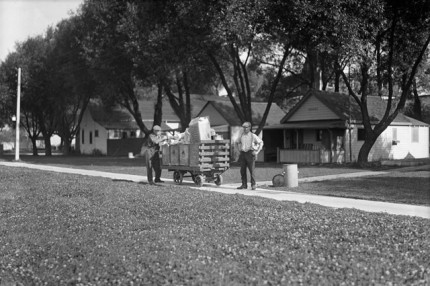Blog Series Part 1: Food Waste Before World War II
Posted: September 29, 2016
Categories: GoodFoodBites / News from Sustain Ontario
Why Food Waste?
Globally, around one third of all food produced is lost or wasted. Canadians currently waste $31 billion worth of food every year, with consumers responsible for almost 47% of the value. Why do we throw away so much food? It turns out that cultural practices, habits and institutionalized social norms play a big part in why we waste food.
This is the first in a five-part series about food waste in which we explore how Canadians dealt (and deal) with food in the past, present and future.
FOOD WASTE BEFORE WWII
In 1851, nearly 9 out of 10 Canadians lived in rural areas. Many of these rural dwellers were farmers or working with other primary resources such as forestry or fishing. With no garbage collection or off-site dumping options, organic waste was fed to livestock like many farmers still do today. Pigs were especially great scrap eaters, efficiently clearing up waste, converting it to food (pork) and producing manure to keep soil fertile.

Source: Library and Archives Canada
Many housewives were skilled in preserving food and stretching its use as far as possible. To prevent food from going to waste, leftovers were repurposed to create new dishes. According to Susan Strasser in her book Waste and Want: A Social History of Trash in the United States, inedible foods were not thrown away either – leftover fat could be used for cooking or to soothe chapped hands. Women also used leftover grease to make into candles and soap. Tallow candles commonly were made from mutton or beef suet. After butchering, wicks would be dipped into large vats of hot fat. Soap was made by combining grease with lye.
As Canada became more industrialized, rural dwellers moved to cities to work in factories. By 1911, 45% of Canadians lived in urban areas. Roaming bands of orphans called “swill” children gathered kitchen refuse to sell to farmers for fertilizer or hog food. Instead of making the goods themselves, some urban housewives traded their ashes and grease with chandlers in exchange for soap. This was the equivalent of today’s recycling service – goods that were useless to households could be traded to peddlers who would then sell to factories and use the profit to buy household goods which were again traded with housewives for scrap.
Without refrigeration, housewives and servants used many creative techniques for keeping leftovers edible. According to Strasser, techniques to “purify” rancid butter and to keep poultry and loaf cake fresh were only some of the methods suggested by Lydia Maria Child, author of the 1829 book The American Frugal Housewife. With the advent of iceboxes, households faced similar problems as today – odds and ends stuffed into the fridge often were forgotten, leading to smelly rot.

Source: City of Toronto Archives, via Torontoist.
In Canada, as cities increased in density, food waste increased and garden space around homes was not sufficient to take the refuse. Worries about public health prompted municipalities to take action. In the 1860s after a cholera outbreak, the city of Toronto was spurred to invest in public health by institutionalizing a formal garbage collection. Trash was incinerated, with the ash going into the ravines or the harbour. With routine garbage collection clearing the streets of garbage, the food waste, among other trash, could be tossed out of sight and out of mind.
Stay tuned for the next chapter in this food waste blog series: Food Waste During WWII
Sources:
Global Food Losses and Food Waste, FAO
Food Waste in Canada: “$27 Billion” Revisited, VCM International
Statistics Canada
“Toronto’s garbage woes have long and smelly history”, The Globe and Mail
Waste and Want: A Social History of Trash by Susan Strasser
